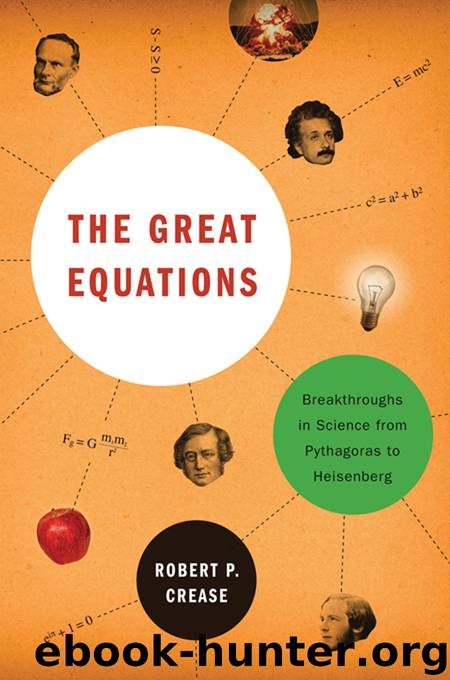The Great Equations by Robert P. Crease

Author:Robert P. Crease
Language: eng
Format: epub
Publisher: W. W. Norton & Company
Published: 2012-04-25T16:00:00+00:00
Celebrity Status
Ethnographers say that when two cultures interact, they do not meet all of a piece but through “congeners” through which certain members of one culture look at, try to understand, and respond to the other. Congeners can include artifacts, rituals, practices, and art; fear, fascination, and exoticism usually play a role. A congener is like a little lens that allows the members of the one culture to approach the other culture in a focused way, to get an introductory grip. A congener is thus more than a symbol or logo of the other culture, but guides and disciplines curiosity and fascination into a first interaction with it.
The equation E = mc2 served as a congener in this sense, between a public anxious for information about atomic energy and the scientific developments that made it possible. In the process, it grew into even more—a symbol of physics, of science, even of knowledge—to the point where it acquired a mythic status.
The French intellectual Roland Barthes once wrote an essay on Einstein in which he noted that, while photographs of Einstein often show him next to a blackboard covered with impenetrable symbols and equations, cartoons of him often portray him, chalk in hand, next to a clean blackboard on which he has just written down this particular formula as if it just came to him out of the blue. Barthes observed of the symbolic character of this equation that it restores the image of “knowledge reduced to a formula . . . science entirely contained in a few letters.” It has become a Gnostic image: “the unity of nature, the ideal possibility of a fundamental reduction of the world, the unfastening power of the word, the age-old struggle between a secret and an utterance, the idea that total knowledge can only be discovered all at once, like a lock which suddenly opens after a thousand unsuccessful attempts.” Barthes’s essay helps explain the transformation of this equation from a scientific tool into a congener.
Einstein himself began to use the equation in its now-famous, simplified form. In April 1946, the first issue of a new popular magazine, Science Illustrated, appeared with an article written by Einstein entitled “E = mc2.” “It is customary,” he wrote, “to express the equivalence of mass and energy (though somewhat inexactly) by the formula E = mc2.”32
Then, on July 1, 1946, less than a year after the explosions over Hiroshima and Nagasaki, and just shy of 41 years after it first appeared in its initial form, E = mc2 made the cover of Time magazine. The issue coincided with an atomic test in the South Pacific. The Time cover juxtaposed a portrait of the now white-haired, 66-year-old Einstein, whom it called a “shy, almost saintly, childlike little man,” next to a fiery mushroom cloud rising above the hulks of warships. Red flames at the base gave way to orange and purple on the column, topped by a gray mushroom cap. On it was inscribed a now-infamous equation: E = mc2.
Download
This site does not store any files on its server. We only index and link to content provided by other sites. Please contact the content providers to delete copyright contents if any and email us, we'll remove relevant links or contents immediately.
| Applied | Geometry & Topology |
| History | Infinity |
| Mathematical Analysis | Matrices |
| Number Systems | Popular & Elementary |
| Pure Mathematics | Reference |
| Research | Study & Teaching |
| Transformations | Trigonometry |
Modelling of Convective Heat and Mass Transfer in Rotating Flows by Igor V. Shevchuk(6391)
Weapons of Math Destruction by Cathy O'Neil(6143)
Factfulness: Ten Reasons We're Wrong About the World – and Why Things Are Better Than You Think by Hans Rosling(4694)
Descartes' Error by Antonio Damasio(3230)
A Mind For Numbers: How to Excel at Math and Science (Even If You Flunked Algebra) by Barbara Oakley(3217)
Factfulness_Ten Reasons We're Wrong About the World_and Why Things Are Better Than You Think by Hans Rosling(3199)
TCP IP by Todd Lammle(3134)
Fooled by Randomness: The Hidden Role of Chance in Life and in the Markets by Nassim Nicholas Taleb(3044)
Applied Predictive Modeling by Max Kuhn & Kjell Johnson(3018)
The Tyranny of Metrics by Jerry Z. Muller(3000)
The Book of Numbers by Peter Bentley(2912)
The Great Unknown by Marcus du Sautoy(2646)
Once Upon an Algorithm by Martin Erwig(2598)
Easy Algebra Step-by-Step by Sandra Luna McCune(2583)
Lady Luck by Kristen Ashley(2532)
Practical Guide To Principal Component Methods in R (Multivariate Analysis Book 2) by Alboukadel Kassambara(2497)
Police Exams Prep 2018-2019 by Kaplan Test Prep(2484)
All Things Reconsidered by Bill Thompson III(2355)
Linear Time-Invariant Systems, Behaviors and Modules by Ulrich Oberst & Martin Scheicher & Ingrid Scheicher(2333)
